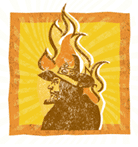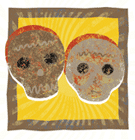November Traditions
BY Carole Wirszyla
In America November is the month when we celebrate Thanksgiving. With our turkey football and eat-til-you-sleep mindset its easy to imagine that the rest of the world stands still while we gather around the table and say “Happy Thanksgiving.” But the world does not stand still. In fact there are some very interesting November traditions taking place around the globe while Americans carve the collective bird. In the southern hemisphere on the first Tuesday in November fashion is a bigger focus than food for “the day that stops a nation.” The Melbourne Cup held by the Victoria Racing Club on Flemington Racecourse in Melbourne Australia can attract more than 110 000 people dressed in all manner of exotic and amusing costumes. “Fashion is a big focus particularly womens hats ” says Claire Cahill a stay-at-home mom living in Sydney Australia. In recent years headpieces known as Fascinators made with feathers flowers and beads have become increasingly popular. Fashion aside the Melbourne Cup became a public holiday in 1877 in Victoria and is today regarded as the most prestigious “two-mile” handicap horse race in the world. Originally held over two miles the race is actually 18 meters shorter since metrication in the 1970s. Along with the rest of Australia the Cahills watch the event referred to as a carnival on television but partying is the order of the day and many people gather at clubs to watch and celebrate. Flowers especially roses are an important component the racecourse is adorned with nearly 120 000 roses encompassing more than 200 varieties.
The Melbourne Cup The Day that Stops a Nation
 In his book Following the Equator: A Journey Around the World American writer Mark Twain said of a visit to the Melbourne Cup in 1895: “Nowhere in the world have I encountered a festival of people that has such a magnificent appeal to the whole nation. The Cup astonishes me.”
In his book Following the Equator: A Journey Around the World American writer Mark Twain said of a visit to the Melbourne Cup in 1895: “Nowhere in the world have I encountered a festival of people that has such a magnificent appeal to the whole nation. The Cup astonishes me.”
Armistice Day
 Known as Veterans Day in America and as Armistice Day or Remembrance Day in other parts of the world this holiday honors the soldiers who fought and died in World War I. It is observed on November 11 the anniversary of the signing of the Armistice that ended the war the Germans signed at the 11th hour of the 11th day of the 11th month of 1918.
Known as Veterans Day in America and as Armistice Day or Remembrance Day in other parts of the world this holiday honors the soldiers who fought and died in World War I. It is observed on November 11 the anniversary of the signing of the Armistice that ended the war the Germans signed at the 11th hour of the 11th day of the 11th month of 1918.
Flowers or more specifically poppies became the symbol of Armistice Day because they were described as blooming in some of the worst battlefields in Flanders in John McCraes poem In Flanders Fields. Today veterans of all wars are remembered on November 11. It is a public holiday in many countries.
Guy Fawkes Night
Remember remember the 5th of November Gunpowder treason and plot
I see no reason why gunpowder treason Should ever be forgot.
 Being told that you came into the world “with a bang” might conjure up some intriguing images but to literally be born among bangs crackles and flashes in England can only mean one thing: you were born on November 5 Guy Fawkes Night.
Being told that you came into the world “with a bang” might conjure up some intriguing images but to literally be born among bangs crackles and flashes in England can only mean one thing: you were born on November 5 Guy Fawkes Night.
In 1604 during the reign of King James I there was great religious unrest in England. Although the King wanted Catholic and Protestant harmony the government was against the practice of Catholicism. Public worship was forbidden and those who broke the rules were convicted and executed. At this time Protestant-born Guy Fawkes who had converted to Catholicism along with 12 other conspirators plotted to blow up the Houses of Parliament to make way for new leaders.
It took Fawkes and his men almost a year to dig tunnels beneath nearby buildings but access was finally gained through an adjoining cellar and gunpowder barrels were planted. Parliament was due to be opened by the King on November 5 1605 so Guy Fawkes took up his position the night before.
With so many conspirators involved in the plot the secret was destined to slip. It was leaked by a man who had a relative in Parliament that he did not wish to see harmed. The cellars were searched and Fawkes was arrested. Despite rumors that he was burned at the stake Fawkes and fellow conspirators caught in the ensuing man-hunt were later hung drawn and quartered.
The end result was somewhat bittersweet: The King and his government were saved but the Catholic movement was further devastated for some 200 years after that event.
Though the event is not a public holiday it is celebrated in two ways: November 4 is designated as Mischief Night where British children trick or treat in memory of the mischief of Guy Fawkes and November 5 is known as Guy Fawkes Night but is also called Bonfire Night because fires are lit.
Jill Summers British mother of two says “Kids make an effigy of Guy and go around with it in a wheelbarrow shouting Penny for the Guy before mounting it on top of the fire to burn.” Fireworks displays are held potatoes are wrapped in foil and baked over the fire chestnuts are roasted and ginger parkin (a classic Yorkshire ginger cake) is passed around. Hot beverages are popular and the atmosphere is festive.
All Saints Day & All Souls Day
 Festivities of a different kind are celebrated by other countries in early November starting with the first two days: November 1 is known as All Saints Day and November 2 is known as All Souls Day.
Festivities of a different kind are celebrated by other countries in early November starting with the first two days: November 1 is known as All Saints Day and November 2 is known as All Souls Day.
November 1 was chosen by the Roman Catholic Church in 835 AD to honor all of the saints. Another word for saint is hallow hence the previous evening is known as Eve of All Hallows or Halloween. The intention was to frighten away the evil spirits and make way for honoring the saints. Meanwhile November 2 was designated by the Catholic Church to honor the dead. Many people associate death with sadness but All Souls Day is a celebration of the dead in many cultures.
In Mexico Dia de Los Muertos (Day of the Dead) is a day for families to rejoice and celebrate the memory of their lost loved ones together. They make special bread (pan de muerto) and sugar-covered molds of skulls skeletons and bones. Families dress up and take part in parades that progress through town to the cemetery where candles are lit and the revelers dance and play music.
In Brazil Dia dos Finados or Dia dos Mortos (Day of the Dead) is a national holiday and quite a somber day. “People usually take flowers and spend time praying and thinking about the deceased ” says Claire Dallas-Gonalves a schoolteacher in Brazil.
Lithuanians carry out many age-old traditions in early November to remember loved ones believing that the souls of the dead return to their homes at that time. Families visit cemeteries decorate graves with beautiful flowers and light candles and bonfires. Alex Wirszyla who was born into a Polish-Lithuanian family but raised in America remembers that families went to church but at home they would share traditional foods like borscht (beet soup) buckwheat porridge zasuwalka (potato pudding) meat (generally chicken) and buckwheat cake.
St. Andrews Day
 November 30 is the date traditionally set aside for the Scottish to commemorate St. Andrew Patron Saint of Scotland. Though a holiday for generations it was only declared a public (or bank) holiday in 2006. It is a flag holiday but curiously though it is a day to honor Scotlands patron saint until 2002 it was the UKs Union flag that flew from Scotlands flagpoles. The Scottish Parliament petitioned the government of the United Kingdom to allow the official flag of Scotland the Saltire to be flown on the 30th and finally persevered.
November 30 is the date traditionally set aside for the Scottish to commemorate St. Andrew Patron Saint of Scotland. Though a holiday for generations it was only declared a public (or bank) holiday in 2006. It is a flag holiday but curiously though it is a day to honor Scotlands patron saint until 2002 it was the UKs Union flag that flew from Scotlands flagpoles. The Scottish Parliament petitioned the government of the United Kingdom to allow the official flag of Scotland the Saltire to be flown on the 30th and finally persevered.
According to Scottish-born creative writing professor Sharon Norris St. Andrews Day is not celebrated in too big a way. Norris says “When I was young it was the one time other than Burns night that we ate haggis and traditional Scottish food like herring in oatmeal or finnan haddie (smoked haddock).” Ceilidhs (Scottish or Irish dances) take place at official celebrations held in the cities and men may wear tartan kilts.
From coast to coast our multicultural society connects with its roots through centuries-old traditions remembered and practiced each November. So this Thanksgiving why not take a moment when youre considering eating one more piece of pie to contemplate the diverse population that makes America a country with plenty to celebrate.
Coincidentally Carole Wirszyla was born in England on the memorable eve of November 5 Guy Fawkes Night though 360 years after the event.